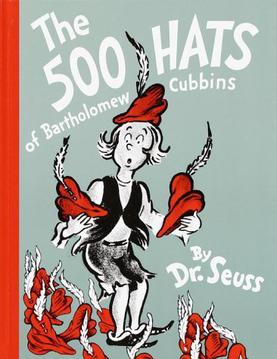The 500 Hats of Bartholomew Cubbins facts for kids
 |
|
| Author | Dr. Seuss |
|---|---|
| Cover artist | Dr. Seuss |
| Country | United States |
| Language | English |
| Genre | Children's literature |
| Publisher | Vanguard Press |
|
Publication date
|
September 1, 1938 (renewed 1965) |
| Media type | Print (Hardcover) |
| OCLC | 192190 |
| Preceded by | And to Think That I Saw It on Mulberry Street |
| Followed by | The King's Stilts |
The 500 Hats of Bartholomew Cubbins is a children's book, written and illustrated by Theodor Geisel under the pen name Dr. Seuss and published by Vanguard Press in 1938. Unlike the majority of Geisel's books, it is written in prose rather than rhyming and metered verse. Geisel, who collected hats, got the idea for the story on a commuter train from New York to New England, while he was sitting behind a businessman wearing a hat; the passenger was so stiff and formal that Geisel idly wondered what would happen if he took the man's hat and threw it out the window. Geisel concluded that the man was so "stuffy" that he would just grow a new one.
The characters of Bartholomew and King Derwin returned a decade later in Bartholomew and the Oobleck.
Plot summary
Set in feudal times, the story begins in the Kingdom of Didd. Young peasant, Bartholomew Cubbins lives on the outskirts of the kingdom with his family; He wears a simple red hat with a single white feather that has remained within the family for generations. One day, Bartholomew is sent into the town to sell some berries, when he comes across King Derwin riding through a street. As per law, one is supposed to remove his or her hat when the king passes by, but Bartholomew apparently does not follow the rule, despite having a hat in his hand and is ordered to remove the hat on his head. Bartholomew does so, but another hat mysteriously appears; when he attempts to remove this one, yet another one appears. For unknown reasons, whenever Bartholomew removes one hat, another one appears on his head.
The young boy is taken to the castle where numerous people attempt to remove the hat from Bartholomew's head, but all attempts end in failure. The royal hatter runs away in terror, the King's young nephew fails to shoot the hats off with arrows, a great bowman similarly fails with a long bow, and Wizards attempt to curse the hat away but claim that their spell would only work in "Ten Short Years". The King, exasperated by all the attempts, sends Bartholomew to be executed, but once again the laws get in the way as a person cannot be executed by the Executioner with his or her hat on.
The King's Nephew suggests throwing Bartholomew from the highest tower as a punishment. The King, while mildly upset by the idea, agrees. Bartholomew begins to push his hats off rapidly as they climb the tower. As this continues, the hats begin to grow in extravagance and beauty from the 451st hat onwards. The 451st hat has two feathers, while the 452nd hat has three and the 453rd hat has three feathers and a small gem and so on. Ultimately the 500th hat, is revealed as the greatest, studded with massive gems, plumes of feathers from rare birds and gilding, although Bartholomew seems unaware of the fact. The king is stunned by the beauty of the hat, but the Nephew is more incensed than before at the sight of it. He tries to push Bartholomew off the tower against the King's wishes which results in him being spanked as a punishment. King Derwin grants Bartholomew a reprieve, requesting for all 500 hats in exchange for 500 gold coins. Bartholomew agrees and is sent home with his massive reward, while the King keeps all of the hats in a massive chest to admire for years to come. The story ends with the narrator admitting that no one knows or ever knew what caused this strange event, but it is more than likely that it will never happen again.
Adaptations
- Not long after publication, the story was adapted for an album issued by RCA Victor (Y-339). Narrated by Paul Wing, the audio adaptation had a running time of 13 minutes and 37 seconds. The dramatization featured music and sound effects on two 10" 78 rpm records in a bi-fold sleeve.
- Geisel wrote the script for the 1943 Puppetoon short of the same name for Paramount Pictures, which was produced by George Pal. It also received a nonination for the Academy Award for Best Animated Short Film. Unlike the book's illustrations, in which Cubbins' hats were all the same one, the hats in the film were of many different kinds.
- Minnesota's Children's Theatre Company produced a version of The 500 Hats of Bartholomew Cubbins for the stage in its 1979-1980 season, and says this was the first theater adaptation of a Dr. Seuss work.
See also
 In Spanish: Los 500 sombreros de Bartolomé Cubbins para niños
In Spanish: Los 500 sombreros de Bartolomé Cubbins para niños

